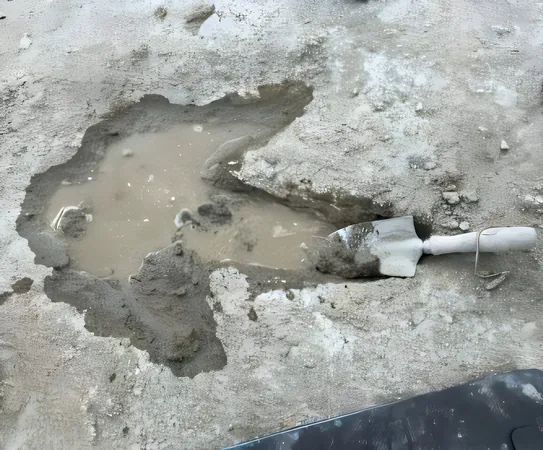
Researchers Unearth Hundreds of Dinosaur Footprints, Revealing a Stunning "Dinosaur Highway"
2025-01-06
Author: Wai
Introduction
In a remarkable breakthrough, a team of paleontologists from the Universities of Oxford and Birmingham has discovered a vast array of dinosaur footprints at Dewars Farm Quarry in Oxfordshire, unveiling what experts are calling a "dinosaur highway." This treasure trove, dating back to the Middle Jurassic Period around 166 million years ago, boasts hundreds of trackways showcasing a variety of different dinosaur species.
Notable Discoveries
Among the notable finds are the massive footprints of the nine-meter-long predator Megalosaurus and herbivorous dinosaurs that could reach lengths of up to 18 meters. The excavation revealed five major trackways, with one impressive trackway extending over 150 meters. The four other trackways are believed to belong to gigantic sauropods, likely Cetiosaurus, known for their long necks.
Ecosystem Insights
The diverse array of footprints suggests a vibrant ecosystem where carnivorous and herbivorous dinosaurs co-existed. One of the striking features of the discovery is the intersection of Megalosaurus tracks with those of the sauropods, indicating that these formidable creatures may have crossed paths during their existence.
Expert Reactions
Emma Nicholls, a vertebrate paleontologist at the Oxford University Museum of Natural History, expressed excitement about the find, noting, "Scientists have been studying Megalosaurus for over a century, yet these discoveries prove there is still much to learn about these magnificent animals."
Discovery Process
The discovery was serendipitous; quarry worker Gary Johnson identified unusual bumps while clearing clay, prompting experts to further investigate the site. The research team, supported by Quarry Manager Mark Stanway, meticulously uncovered around 200 footprints over the course of a week in June 2024.
Technological Innovation
Using cutting-edge aerial drone technology, the researchers created highly detailed 3D models of the footprints, ensuring their preservation for future studies. This modern approach significantly differs from prior discoveries in the area, where over 40 sets of footprints were found in 1997 but without the extensive digital documentation available today.
Behavioral Insights
The footprints provide invaluable insights into the behavior and movement patterns of dinosaurs during the Middle Jurassic Period. Kirsty Edgar, a micropaleontologist from the University of Birmingham, highlighted the importance of the trackway, saying, "These footprints provide a fascinating glimpse into the lives of dinosaurs, revealing their movements, interactions, and the tropical environment they traversed."
Geological Context
Moreover, the rich geological context of the site can help reconstruct the ancient habitat—a muddy lagoon where these giants once roamed. Earth scientist Duncan Murdock noted, "The preservation quality is so precise that we can see how the mud deformed under their weight. This, combined with other fossil evidence like burrows and marine shells, offers a vivid picture of the prehistoric environment."
Media Coverage and Future Exhibits
The excavation has drawn attention from media outlets, including the BBC, which plans to feature the findings in the new series "Digging for Britain," airing on iPlayer starting January 7, 2025, and on BBC2 the following day. Additionally, the Oxford University Museum of Natural History will showcase the discovery as part of the "Breaking Ground" exhibition, highlighting significant revelations in paleontology.
Conclusion
The extensive trackways not only enrich our understanding of the Middle Jurassic but also exemplify how modern technology can revolutionize our comprehension of the ancient world. The findings from Dewars Farm Quarry are set to transform not only paleontological research but also our appreciation for these ancient giants that once ruled the Earth.



 Brasil (PT)
Brasil (PT)
 Canada (EN)
Canada (EN)
 Chile (ES)
Chile (ES)
 Česko (CS)
Česko (CS)
 대한민국 (KO)
대한민국 (KO)
 España (ES)
España (ES)
 France (FR)
France (FR)
 Hong Kong (EN)
Hong Kong (EN)
 Italia (IT)
Italia (IT)
 日本 (JA)
日本 (JA)
 Magyarország (HU)
Magyarország (HU)
 Norge (NO)
Norge (NO)
 Polska (PL)
Polska (PL)
 Schweiz (DE)
Schweiz (DE)
 Singapore (EN)
Singapore (EN)
 Sverige (SV)
Sverige (SV)
 Suomi (FI)
Suomi (FI)
 Türkiye (TR)
Türkiye (TR)
 الإمارات العربية المتحدة (AR)
الإمارات العربية المتحدة (AR)